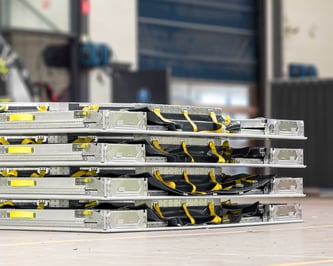An illustration in reducing your carbon footprint with the latest, fully certified collapsible ULDs
It can be difficult to visualise how a product might fit into your daily business operations, especially if that product adopts new or emerging technology. Therefore, we’ve produced this business use case. It explains how collapsible ULDs like the AAX or AAY could help your organisation achieve its emissions goals. The scenario is fictional; the results illustrate the potential effect of introducing collapsible ULDs to your fleet.
Our ULD Manager’s challenge:
To reduce the airline’s CO2 emissions by 5kt in just one year by finding and implementing efficiencies in his ULD fleet management.
Cutting ULD Emissions: Mark's Scenario to Cut Carbon Footprint by 5kt in One Year
Mark is the ULD Manager for an international cargo airline based in Europe. His main role is to keep track of all ULD movements for the airline and to ensure the most efficient and cost-effective flow of goods for all stakeholders. However, he’s just been given a new responsibility: reducing the airline’s CO₂ emissions by 5kt in just a year.
How much is 5kt? It’s 5,000,000 kg of carbon dioxide, which equates roughly to the output of 630 homes in the USA for one year1.
It’s a huge challenge for the company and for Mark personally. He is aware that aviation is a major contributor to global carbon emissions and that his company’s air cargo sustainability strategy includes achieving a smaller carbon footprint. Nevertheless, he’s enthusiastic about playing a role in reducing the environmental impact of transporting containerised cargo around the world.
After doing the research, he’s arrived at his two most impactful options:
1. Replacing current ULD fleet with more lightweight containers
The heavier the container, the higher the plane’s fuel consumption, so a fleet of lighter ULDs would certainly help move the airline’s emissions needle in the right direction. Yet a fleet of new units would require a capital outlay of at least €650,000. It would also be a huge logistical operation with a long lead time. He concludes that he doesn’t have the budget, time or bandwidth for that.
2. Reducing the percentage of empty containers on each flight
Over the years, Mark has introduced many ULD management efficiencies. However, the repositioning of empty containers is still a major operational and financial headache. The average percentage of empty containers on each flight is around 9%. Reducing this number would save the airline money, optimize its container flows and put a serious dent in its carbon emissions footprint. It’s a triple whammy he can’t ignore.
Calculating the Impact of Cutting ULD Emissions
After some basic calculations, Mark has worked out that repositioning empty ULDs by plane costs the airline an eye-watering €3,375,000 a year. That figure doesn’t even account for additional storage fees or handling charges. He then looks at the emissions that a single A330-200F emits2 on a long-haul trip. On average, it’s about 200 metric tons of CO₂, depending on variables such as routes, weather and load factor.
A few more taps on the calculator tell Mark that he needs to eliminate about 25 long-haul trips a year to meet his challenging emissions target. Sharing equipment with third parties and moving surplus containers by sea when it makes sense has been helping recently, but it’s not nearly enough. He needs another way to minimise the number of empty containers being repositioned by plane.

Exploring the many benefits of collapsible containers
The ULD Manager decides to look at collapsible containers and how they could be used strategically within his company. He goes to VRR, the only manufacturer in the world that produces fully certified collapsible containers, to discuss the options.
He learns that collapsible ULDs—when empty—can be stacked at least three high on the main deck of an A330-200F, four high on the lower deck and even six high in a regular 40ft shipping container. They are also just as durable as the standard version and have the same capacity, so there would be no problems integrating them into his existing fleet.
This all sounds promising to Mark. It may not reduce the number of empty ULDs being repositioned, but it would reduce the cost significantly and it would create more deck space, giving him the opportunity to load additional full ULDs. He wonders what the impact of several collapsible containers in his fleet would have on the airline’s emissions.
Using the main deck as the limiting factor, here’s the calculation:
Basically, a collapsible ULD can cut the space that empty containers take up on a main deck by two-thirds. That is a significant reduction in anyone’s book.
A quick return on investment
The simple calculation above shows that Mark could reduce his percentage of empty ULDs per flight by at least 6 percentage points. Since the airline currently makes 500 long-haul trips a year, that’s the equivalent of eliminating 30 trips a year. In emission terms, that’s 6,000,000 kgs of carbon dioxide, substantially more than Mark’s annual target.
But what about the cost of buying the collapsible containers? That needs to be accounted for as well. VRR calculates that the cost of introducing a sufficient number of collapsible ULDs (representing around 10% to 15% of his current fleet) would be more than covered easily by the €2,250,000 the airline would save in just a year by repositioning 6% fewer empty containers.

The results
Mark has found the solution to meeting his emissions-reduction target: collapsible containers that do the same job as the standard ones but can be stacked for repositioning or storage.
A word about this business use case
This use case is entirely fictional. The aim is to illustrate how VRR’s collapsible containers can be used to reduce repositioning costs, ULD imbalances and carbon emissions. It combines our own expert assumptions with data from reliable online resources and real ULD managers. We have simplified the concept of imbalanced ULD stocks and understand that, in practice, more complicating factors exist.
Want to learn more about collapsible containers and how they could help you reduce your carbon footprint? Go to our website and check out the collapsible AAY and collapsible AAX. Or contact one of our specialists.
Solve even more operational problems
Our collapsible containers not just help you where it comes to sustainability goals. Their ability to collapse and be stacked, helps you solve even more daily operational challenged. Please let us show you how in this free infographic.
1 EPA.gov












